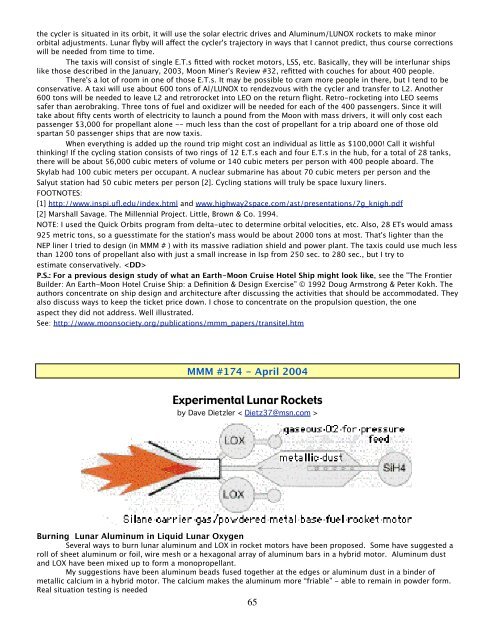Space Transportation - mmmt_transportation.pdf - Moon Society
Space Transportation - mmmt_transportation.pdf - Moon Society
Space Transportation - mmmt_transportation.pdf - Moon Society
Create successful ePaper yourself
Turn your PDF publications into a flip-book with our unique Google optimized e-Paper software.
the cycler is situated in its orbit, it will use the solar electric drives and Aluminum/LUNOX rockets to make minor<br />
orbital adjustments. Lunar flyby will affect the cycler's trajectory in ways that I cannot predict, thus course corrections<br />
will be needed from time to time.<br />
The taxis will consist of single E.T.s fitted with rocket motors, LSS, etc. Basically, they will be interlunar ships<br />
like those described in the January, 2003, <strong>Moon</strong> Miner's Review #32, refitted with couches for about 400 people.<br />
There's a lot of room in one of those E.T.s. It may be possible to cram more people in there, but I tend to be<br />
conservative. A taxi will use about 600 tons of Al/LUNOX to rendezvous with the cycler and transfer to L2. Another<br />
600 tons will be needed to leave L2 and retrorocket into LEO on the return flight. Retro-rocketing into LEO seems<br />
safer than aerobraking. Three tons of fuel and oxidizer will be needed for each of the 400 passengers. Since it will<br />
take about fifty cents worth of electricity to launch a pound from the <strong>Moon</strong> with mass drivers, it will only cost each<br />
passenger $3,000 for propellant alone -- much less than the cost of propellant for a trip aboard one of those old<br />
spartan 50 passenger ships that are now taxis.<br />
When everything is added up the round trip might cost an individual as little as $100,000! Call it wishful<br />
thinking! If the cycling station consists of two rings of 12 E.T.s each and four E.T.s in the hub, for a total of 28 tanks,<br />
there will be about 56,000 cubic meters of volume or 140 cubic meters per person with 400 people aboard. The<br />
Skylab had 100 cubic meters per occupant. A nuclear submarine has about 70 cubic meters per person and the<br />
Salyut station had 50 cubic meters per person [2]. Cycling stations will truly be space luxury liners.<br />
FOOTNOTES:<br />
[1] http://www.inspi.ufl.edu/index.html and www.highway2space.com/ast/presentations/7g_knigh.<strong>pdf</strong><br />
[2] Marshall Savage. The Millennial Project. Little, Brown & Co. 1994.<br />
NOTE: I used the Quick Orbits program from delta-utec to determine orbital velocities, etc. Also, 28 ETs would amass<br />
925 metric tons, so a guesstimate for the station's mass would be about 2000 tons at most. That's lighter than the<br />
NEP liner I tried to design (in MMM # ) with its massive radiation shield and power plant. The taxis could use much less<br />
than 1200 tons of propellant also with just a small increase in Isp from 250 sec. to 280 sec., but I try to<br />
estimate conservatively. <br />
P.S.: For a previous design study of what an Earth-<strong>Moon</strong> Cruise Hotel Ship might look like, see the "The Frontier<br />
Builder: An Earth-<strong>Moon</strong> Hotel Cruise Ship: a Definition & Design Exercise” © 1992 Doug Armstrong & Peter Kokh. The<br />
authors concentrate on ship design and architecture after discussing the activities that should be accommodated. They<br />
also discuss ways to keep the ticket price down. I chose to concentrate on the propulsion question, the one<br />
aspect they did not address. Well illustrated.<br />
See: http://www.moonsociety.org/publications/mmm_papers/transitel.htm<br />
MMM #174 - April 2004<br />
Experimental Lunar Rockets<br />
by Dave Dietzler < Dietz37@msn.com ><br />
Burning Lunar Aluminum in Liquid Lunar Oxygen<br />
Several ways to burn lunar aluminum and LOX in rocket motors have been proposed. Some have suggested a<br />
roll of sheet aluminum or foil, wire mesh or a hexagonal array of aluminum bars in a hybrid motor. Aluminum dust<br />
and LOX have been mixed up to form a monopropellant.<br />
My suggestions have been aluminum beads fused together at the edges or aluminum dust in a binder of<br />
metallic calcium in a hybrid motor. The calcium makes the aluminum more “friable” - able to remain in powder form.<br />
Real situation testing is needed<br />
65















